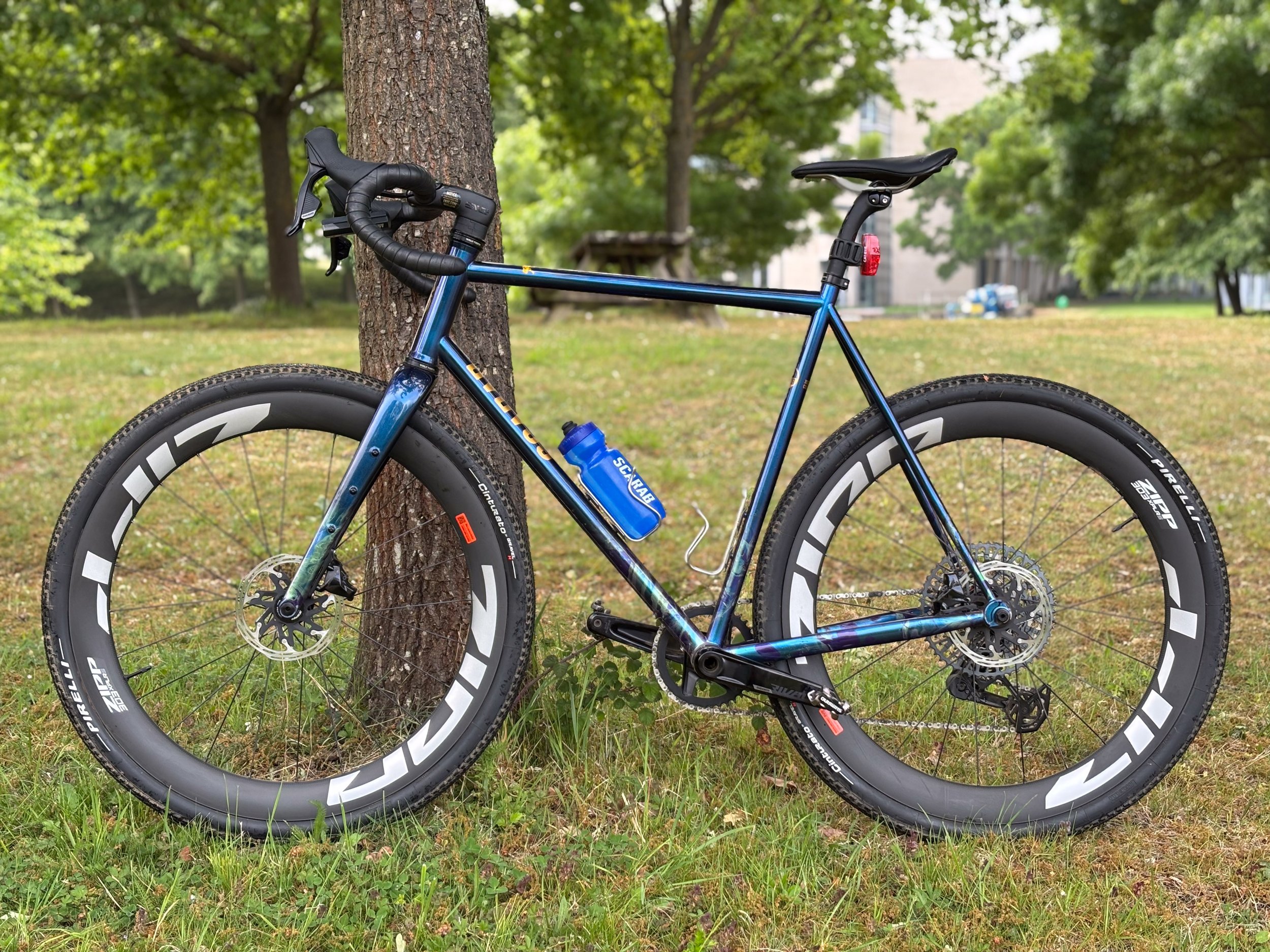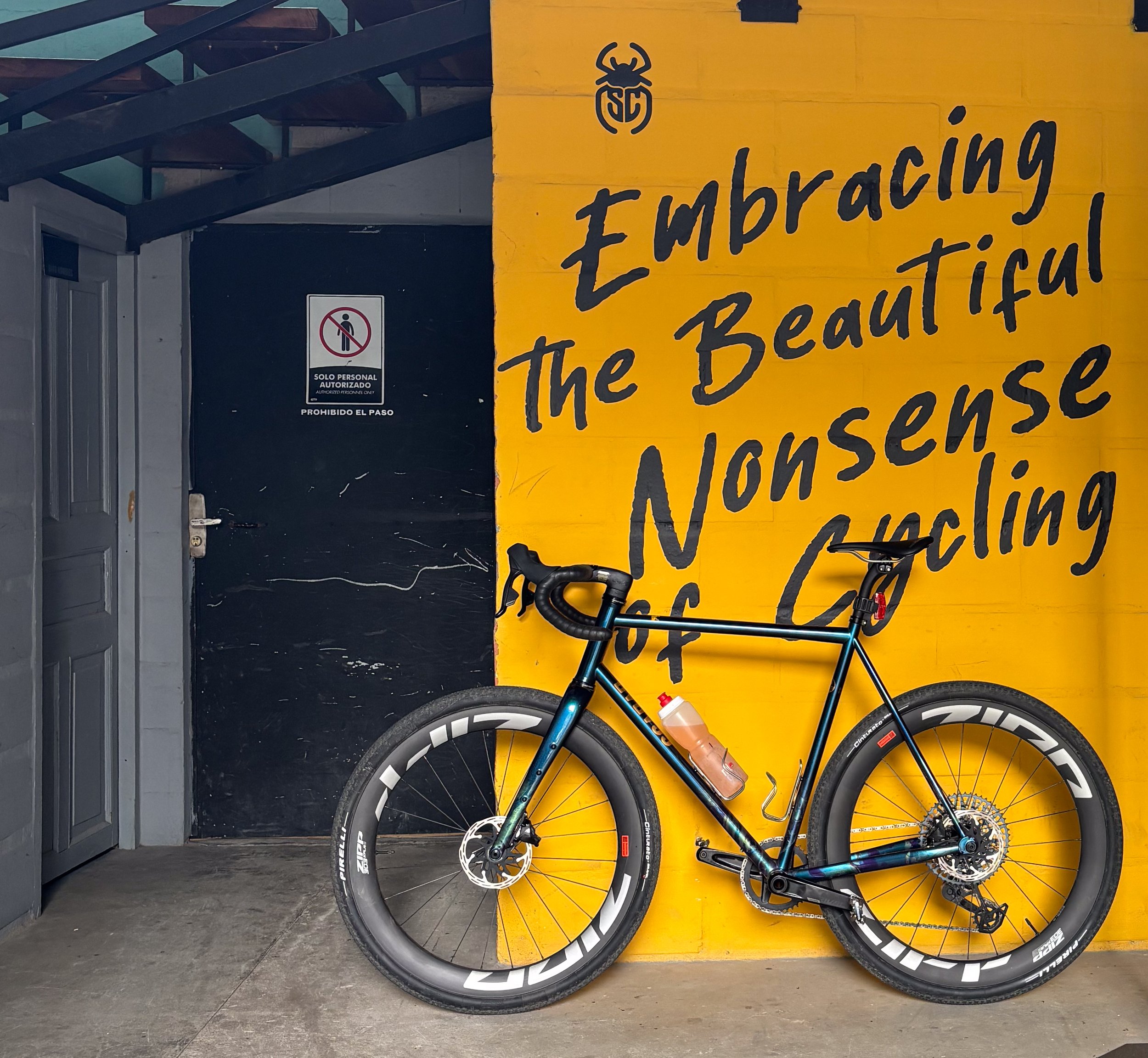En Colombia, no hay llanuras.
Border controls can be a bit tense on a good day, and the news coming from the United States made this one even more so. Especially if, as I was about to do, my answer to the “Purpose of your visit?” question was going to be “Transferring through to Colombia for a cycling trip”.
As it turned out, no one of the officials in Pittsburgh – the world’s beigest airport – cared one bit. There wasn’t a secondary, or any other questions. My bike bag wasn’t given a second glance, which was quite good because – but for some spares and a lot of cardboard – it was empty: my rig was waiting for me in Colombia.
In the beginning, a bicycle was a bicycle. Then, when it transpired that cycling was the only thing sitting at the intersections of the “what I like” and “what I’m decent at” Venn Diagrams, I started thinking about getting my ‘forever bike’. Not long thereafter, I found Scarab Cycles.
First impressions can be deceiving, but the hunch that this part of Colombia wasn’t big on flatlands started to loom larger on my mind as the taxi carried me from Medellín airport towards El Retiro, the town on the outskirts of which Scarab was based. “En Colombia, no hay llanuras” I commented to the driver, a young man from Medellín whose girlfriend, he told me as soon as he saw my bag, was pro mountain biker. He laughed and concurred. Antioquia department, he said, was very hilly. Good for climbing.
Julian, a young and energetic designer, hosted me at Scarab’s. The company, more artisanal atelier than factory, was deserted on Good Friday, but Julian was still keen to show me around. For hours he explained the process that I’d gone through with my bike: from a couple of Google Meets and a few emails to a CAD design and, finally, reality. Columbus steel tubing, the Iconic brand from Milan that was used by all the greats from Gimondi to Merckx, from Coppi to Moser, laser-cut precision, welds that ought to be in a museum of fine arts and, then, custom painting of sublime quality. In the end, I couldn’t wait any longer: it was time to head downstairs to go meet my bespoke Páramo bike.
Dusk was falling as I rode back towards El Retiro on my new steed. I’ve never owned a tailor-made suit, but I guess that the feeling of slipping into one mustn’t be too different from that of riding my Páramo. Named after the high-altitude biome that exists up in the Cordilleras of this incredible country, my new bicycle felt as if it was an extension of me. Frame, stack, reach, height – everything, basically – was just spot on. I rode uphill in the crepuscle, roadside restaurants welcoming the Friday night patrons, with a massive smile on my face. A semana santa procession was in full swing in Retiro and, as the faithful carried palanquins with statues of saints along the roads, I was ready to profess eternal fealty to my new steel idol.
Over the next few days, a routine of sorts formed. I’d wake up, have breakfast in a place that only did eggs and then, fortified by the proteins, I’d head out to ride. Julian would often ride with me, and what a patient guide he was. Because I was in for a rude awakening.
A typical ride would last for about 50, 60 km. On a normal day, in London, this would be nothing more than a leg shaker. But I was a long way from London: we’d head out of Retiro and, in the space of no more than 7 km, we’d gain 200 metres in elevation, only to lose them again. Then we’d do it again, and again, and again. The roads only had two settings: rising at a 20-degree angle or descending with same steepness. As I wheezed and panted up another steep ascent, legs jellied by the heat, humidity and altitude, it dawned on me why Colombia produced so many Grand Tour climbers. It was natural selection.
Painful as it was, the experience was worth it. Around us were avocado orchards, lone finca campesinas painted in vivid colours, fragrant thickets of eucalyptus and pines, and so many flowers I had never seen before. A sudden breeze would shake the canopy, and, without warning, we’d be riding under a delicate rain of purple petals.
Hill followed hill in an impenetrable jumble of valleys and cordilleras, like a green sea churned by the winds and currents. We climbed through woods that smelt of resin and descended past flower plantations, feasting our eyes on the tropical elegance of these lands. Carryon birds – at first I thought they were condors, but Julian told me that they were three times as large – cruised up above, riding the thermals.
Away from sealed roads, traffic reduced to a treacle. Chinese motorbikes were our most frequent encounters. Everyone went slowly, which gave us time to exchange greetings. Coffee farmers, leathery and lean in their Stetson hats and denim shirts, rode their placid horses and waved at us politely. Dogs, unlike their brethren at other latitudes, were unfailingly friendly and would often approach us for a belly rub. Music oozed out of windows and roadside cafes, but the biggest sound system in the land belonged to the chivas.
A chiva is an old bus plying the rural roads. Scrupulously hand-painted by skilled craftsmen in Medellín, they were the lifeblood of small communities, ferrying people and cargo in, and often above, its massive open-air seating area. On Saturday, somewhere south of Retiro, we turned a corner and found ourselves staring at the back of such a chiva, sitting idle in the middle of the dirt road.
As it turned out, it was just a comfort break for an elderly passenger who promptly climbed the ladder up to the roof and, with a double cloud of smoke, the chiva was again on the move, its sound system roaring back into life and, with it, a karaoke session. The music was an upbeat cumbia about a lady who loved her husband and, from inside the bus, came the sound of dozens of female voices singing along. The road twisted and turned, climbing as it did, and the old chiva struggled uphill like a beast of burden. We rode on its tail, listening to the careless singing, dancing and laughing.
“Happy people”, smiled Julian.
A rusty gate rose to close a particularly gnarly climb we’d been doing for a few kilometres. Further afield, we could make out the city of Rionegro but, right now, we couldn’t go any further. Julian and I stopped for a quick snack break and, while munching, I tried to peer through the iron bars. The wreck of a villa built in 1980s-chic style was being slowly reclaimed by the jungle.
“That belonged to Pablo”, said Julian. Yes, that Pablo.
The destination of my trip had caused plenty of irony back at home, often referring to the job held by the erstwhile owner of the ruined villa, and the substance he was exporting. But I knew that what was an innocuous joke at home was a painful memory here, where Colombians paid a hefty price for having the War on Drugs being fought – and arguably lost – on their lands and on their bodies. So I steered clear of the topic, and didn’t press the matter further, especially as that era seemed to be a hazy memory.
Back in town, Colombians flocked to the main square of Retiro. I’d often sit on the sidelines, beer in hand, to witness the faithful in the church, teenagers flirting in the cafes, and punters having drinks in the bars. A lady introduced a plump toddler to a trio of female police officers standing under the awnings of City Hall, and each of the ladies in uniform took turns to hug and kiss the cooing infant. When I left Retiro for Medellín I found a city where, last year, recorded about half the murders of Chicago.
Eventually, however, it was time for me to be packing my new bike and head home. I left Medellín way before dusk, riding yet another taxi uphill towards the international airport. My stay had been, as per usual, way too short, but I was leaving with quite the souvenir: my new Páramo, a reminder of a country where the views are amazing, people are kind and the cycling is, well, bloody hard.

















